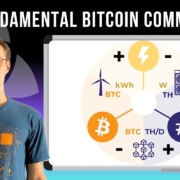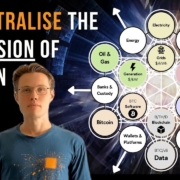Bitcoin is an ENERGY Currency with Electron Elasticity?!? | Hashpower Academy
Bitcoin’s not just money—it’s peer to peer ‘electronic’ cash, an energy currency with a twist! In this mind-bending dive, I unpack its electricity exchange rate and “electron elasticity”—how block rewards set the global energy price, while miners’ hardware efficiency dials in the local BTC/kWh. From watts to wealth, see how Bitcoin rewires economics with arbitrage and abundance. Watch now—discover why BTC’s the ultimate power play!
Hashpower Academy Donations (Thank You!):
L1 Bitcoin: bc1qlgkc4pyrz22cykrx49cmuku3zyy2nuequu6r9y
L2 Lightning: academy@walletofsatoshi.com
Free Bitcoin Course! (Big Picture Basics):
https://www.hashpower.academy
I got my Bitcoin Mini-Miner from IXTech (10% off with code JAKE):
https://ixtech.xyz/?ref=JAKE
Align a meeting if you are looking to discuss Mining/Hosting and other Business Inquiries:
https://calendly.com/terahash/30min
Financial Disclaimer:
This video serves educational and informational purposes only and should not be construed as financial advice or investment recommendation. The views expressed are those of the presenter and do not represent Hashpower Academy’s official stance. Information is provided ‘as is’ without warranties, express or implied, as to its accuracy or completeness. Engaging with Bitcoin involves high risk, including potential financial loss, market volatility, and energy costs, and is suitable only for those who can bear these risks. Always conduct your own research and consult with a qualified financial or technical advisor before making decisions related to Bitcoin.
#Bitcoin
#EnergyCurrency
#Economics
#energy
#physics
#BitcoinMining
#btc
#ExchangeRate
#CryptoEconomics
#Arbitrage
#Finance
#BTCkWh
#Cryptography
#Abundance
#Money
#Currency
#bitcoinenergy
#CryptoFinance
#bitcoincity
#Crypto
Video Transcript:
hello there and welcome to the hash power academy my name is Jake Scanland i’m the lead educator here at the academy and this is a place for you to learn anything and everything to do with Bitcoin from its fundamentals of energy computing and also the financial aspects of Bitcoin its blockchain and the context of its dollarized price we teach those components last but the overall gist of this video is to fundamentally and 100% prove that Bitcoin is an energy currency how and why and what is the dynamics between these well these worlds this physics and finance well we’re going to look at the electron elasticity of Bitcoin which if you are a physicist or an economist you have your own understanding of the word elasticity but guess what Bitcoin is the circular integration of these two worlds of energy and finance with well computing and cryptography in the middle and this is the piece that actually defines one side of the pricing system the the production side of how much kilowatt hours you can purchase with one bitcoin because in the early days Satoshi Nakamoto didn’t go into a platform and click buy and exchange dollars into Bitcoin did he in fact every single bitcoin has been produced through a quantity of kilowatts kilowatts to Bitcoin is the original exchange rate of Bitcoin and as more hash rate joins the network it raises the difficulty it raises the electrical cost to produce the bitcoin and every h havinging comes along and cuts the rate in which the bitcoin is distributed per energy cost and so you’ve got this continual repricing over time of more energy chasing fewer sats and that’s its pricing system if you’re holding bitcoin it represents a greater quantity of energy to produce your purchasing power so to speak and so this video is going to absolutely fundamentally prove that Bitcoin is an energy currency and what we’re going to look at is well the difficulty right now is 121.51 trillion that’s the difficulty the bar the bar has been set and this constant I’ll still explain in another video but that just boils down uh and multiplies out the difficulty to what the current average twoe looking back hash rate is for the whole network which is 869 xahash and when you multiply that again by 23 that converts the amount of exahash being produced at an average efficiency of 23 jewels per terraash into 20,000 megawatt now if you add an hour to that that’s obviously 20 million boil it down again kilowatt hours and if we look at the 144 blocks per day of 450 Bitcoin in total for the whole day that approximates six blocks at 18.75 this is because subsidy right now is 3.125 Bitcoin per block multiplied by six and you get your 18.75 now for easy numbers we are going to keep it in dollars but the most key thing as well to take away from this video is we can remove the dollar this is going to be the second commodity on a Bitcoin unit of account the first commodity is Bitcoin per virtual bite the very use of sending Bitcoin and paying a fee to store that information data in a block that is the first Bitcoin unit of account component of the network take a breath the second component is that exchange rate at to electricity how and why well because Bitcoin is mathematically connected to electricity because the miners are consuming a quantity of electricity their energy bill which has a dollarized price and they run it through a computer to produce hash rate and capture some of this Bitcoin and so their output quantity of Bitcoin is still mathematically connected in that chain and that has a dollarized price so yes right now we’re managing all these things in a world of dollar premiums but we can strip the dollar away from both components and have a quantity of energy traded to a quantity of Bitcoin and the takeaway for this video looking at the elasticity is well how does that price change because right now we can do the 1.5 million Bitcoin being earned per hour by the network and the 20 million kilowatt hours being consumed so this is the input cost and this is the output revenue rate of an hour and if we divide 1.5 million divided by 20 million you get 0.075 so 7.5 cent of Bitcoin per kilowatt hour so if a if a miner was mining at the large industrial scale and he was consuming energy to earn 7.5 cent a kilowatt hour if the price on the grid went to 10 cents why why would he mine why would he consume the power if he has the ability to demand response and sell the power back to the grid and so that pricing system is is already halfway there where the miners are halfway there in Bitcoin Bitcoin’s second unit of account commodity of electricity but what we’re going to show you here is so I’ve just shown you the the the current rate of the amount of Bitcoin earned per kilowatt hour what would happen if 10% more hash rate comes online what do you think would happen so we’re going to do plus 10% and that would obviously add an extra 20 uh sorry an extra 2 million kilowatt hours at this current revenue rate just keep scribbling these out and writing them back in what do you think would happen so the amount of Bitcoin being earned by the entire network um would get diminished on the producer side but what happens to the consumer side those holding Bitcoin that now your Bitcoin essentially represents an even greater quantity of energy to be exchanged at that rate but it’s not that rate anymore let’s in fact take the scenario that yes 10% more hash rate has come online well this price would be if I have it written down 10% more hash rate so there’s 20 that’ll be dividing the 1.5 million divided by 22 million that’s a smaller number which is where is it 0.068 0.0.68 so more hash rate chasing the fewer bitcoin which means more energy chasing that fewer bitcoin which means the rate the 0.068 068 means that the the the the amount of Bitcoin that an individual miner is earning per kilowatt hour has dropped which means that the price that the miner is willing to sell on the grid has dropped so let me just uh just shatter that theory that Bitcoin is going to take over the world and consume all energy no because the more hash rate that comes online it makes the energy cheaper for the miners to sell and they want to sell the energy because if the miner switches off even a portion of the machine’s energy use underclocking the machine it lowers the jewels per terahash which is increasing the efficiency which reprices his exchange rate for his remaining hash rate online which is to say that Bitcoin has a dynamic elastic pricing system to electricity and the miner will make more money by selling the power so his his computer justifies the capacity to be able to buy power in a contract because he can he has the ability to use the power to export it onto the internet but he will make more money by selling it p to back to the grid and so yeah if more hash rate comes online more miners plugging in using more of the world’s energy it makes the price of energy for consumers cheaper more abundant shall we say and let’s do it the other way around what happens if 10% of the network comes offline let’s say uh 10% of the network we’re we’re in this future world of Bitcoin’s unit of account economics everyone’s living in citadels and consuming power and sharing that power to each other based on their consumption of mining and that available energy on their local citadel grid well if uh 10% of that energy was sold because it’s consumed in the households and 10% of the hash rate came offline um in a twoe average what do you think the price of energy does then so the the system the the planetary system is being priced as less energy chasing fewer sats well what this does is it raises the price to buy the energy so there’s less of a supply of energy available to buy in the system because hash rate is essentially a representation of energy that’s available to be purchased this is what I’m trying to get out here of Bitcoin as an energy currency 08 3 when I first figured this out as a concept goosebumps blew my mind but yeah so when more hash rate comes online the price of energy for you to have to pay for that energy from miners in our Citadel grids of the future gets cheaper more supply of energy in the system more hash rate means more energy supply versus that that amount of uh the price the pricing system on the consumption side is the amount of subsidy and fees per block because that’s what the miner is comparing he’s comparing how much can I earn by exporting the energy to the internet to earn the Bitcoin consuming it how much can I earn selling it locally so the the the global price for energy is what Bitcoin sets through block rewards and this defines a price a price that a local person is willing to sell power in abundance and so yeah we’ve got this uh minus 10% so 10% of the network hash rate has switched off it raises the price for energy for you and so you’ve got this elasticity of an energy price of Bitcoin which is not static it’s dynamic and it’s dynamic to how much energy is available in the system represented as network hash rate because hash rate is just a a projection of the energy available in the system let’s do um the final one of saying well what happens if uh loads of fees rush into the uh consumption side people let’s just say it doubles if uh the amount of if the amount of um uh which number should we use 6 to8 let’s just say that this uh doubles this one doubles so it’s 37.5 bitcoin coin so in an hour miners think they have the potential to earn 37.5 Bitcoin which equals 3 million so now we do the 3 million divided by Which one should we do yeah 3 million divided by the 22 million kilowatt hours we’ve just dollarized to keep it easy how much do you think um how much do you think the the kilowatt hour exchange rate will be if more consumption is in the network miners are recognizing that they can earn more well or double so it’s essentially double this price um because I I’ve this figure I’m going to use it to this one in my numbers which is yeah double literally if if uh I’ll keep it simple whatever the hash rate is whatever the energy is underneath that if the block rewards were to double the energy price doubles which basically means you’ve got this interplay between block rewards defining the the the global price for energy and the miner’s local efficiency setting that that exchange rate price based on that global price so the two key components of this are the miner’s local efficiency and the global price and I see places like um Indonesia anywhere that they have um locationbased limitations that I’m sure all the different thousands of islands they have some form of ability to produce power that now there is the potential that if if there was mining machines on all the little islands consuming energy available on the particular islands it doesn’t make any sense to run power lines between all the islands but if they all consume energy at a global rate they have a global they have a global wireless defined price for energy but it’s all u available at the local level and this is the other thing about Bitcoin mining is this computer that has a global price of energy defined and a justified consumer which justifies the buildout of more production because you’ve got this chicken and egg issue it’s like uh anywhere that you want to build out more energy production uh well you need a consumer if you want if you want to spend the millions to build out energy production you need something that consumes the energy a buyer once one this enterprise costs a lot of money produces a lot of energy this one well still costs a lot of money but converts energy into money and so you’ve got this this duopoly of the energy production side where if you want to build out more civilizational infrastructure in your country it has the ability to have two options of to export that energy locally or globally and all of these pieces create this amazing future where well the more hash rate comes online the more uh purchasing power your Bitcoin has and that this is this is beyond the dollar world because as I said at the start that these are mathematically connected so one of the struggles with trying to understand how we price things in bitcoin if if a quantity of bitcoin is already accounted through mathematics and physics and cryptography to a quantity of electricity the pricing system is already naturally there and what this does is well now you’ve got say electricity priced in Bitcoin well now you can delve into accounting carbon credits on a Bitcoin unit of account you could price oil on a Bitcoin unit of account you could price any other derivation of um producing energy because there’s multiple different layers that you can put underneath electricity and other technology components to produce it i think I’m going to stop there it’s probably a bit of a weird and wonderful topic but yeah Bitcoin is an elastic price of energy based on how much hash rate is online because hash rate online being produced by the proof of producing blocks u and the difficulty adjustment the difficulty adjustment essentially represents the purchasing power of your Bitcoin when difficultyy’s going up your your Bitcoin is gaining more kilowatt hour purchasing power but you’ve also got the component of the efficiency of machines is continually um in decline in the sense that these machines are gaining gaining efficiency by consuming less energy to produce more compute so um Moore’s law is not working against you but um essentially that microchips are continually getting more efficient but they al they’re also hitting chip density limits and uh uh that’s going to be an interesting thing in the future but overall yeah less and less Bitcoin every four years but more and more energy so the in a in a couple hundred years one bitcoin will essentially well even to now I I theorize that one bitcoin has the purchasing power of 10,000 years of a single human’s consumption of energy so yes you could essentially retire your bloodline and there is a way to actually mathematically define what that represents thank you for listening i hope you enjoy this video share it to anyone you think would find this of interest um I’m add I’m going to add it to this sheet that I will be sharing on the channel i hope to see you in the next one like subscribe and I’ll see you goodbye














Leave a Reply
Want to join the discussion?Feel free to contribute!